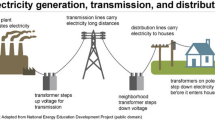Abstract
Pollution externalities between polluters should be taken into account in the design of corrective taxes. When the externalities are substantial and/or the number of polluters is large, the effluent levies on these firms do not necessarily result in a deadweight loss. Consequently, the second-best tax exceeds the marginal social cost of pollution. A more general rule is that the tax rate should be greater than the marginal social cost of pollution if and only if a marginal increase in the tax rate results in opposite effects on the changes of equilibrium emission level and output.
Similar content being viewed by others
References
Barnett, A. H. (1980), ‘The Pigouvian Tax Rule under Monopoly’, American Economic Review 70, 1037-1041.
Baumol, W. J. and W. E. Oates (1988), The Theory of Environment Policy, 2nd edition, Cambridge: Cambridge University Press.
Buchanan, J. M. (1969), ‘External Diseconomies, Corrective Taxes, and Market Structure’, American Economic Review 59, 174-177.
Ebert, U. (1991), ‘Pigouvian Tax and Market Structure’, FinanzArchiv 49, 154-166.
Ebert, U. (1996), ‘Naïve Use of Environmental Instruments’, in C. Carraro, Y. Katsoulacos and A. Xepapadeas, eds., Environmental Policy and Market Structure, Dordrecht: Kluwer Academic Publishers, pp. 45-64.
Ebert, U. and O. von dem Hagen (1998), ‘Pigouvian Taxes under Imperfect Competition If Consumption Depends on Emission’, Environmental and Resource Economics 12, 507-513.
Katsoulacos, Y. and A. Xepapadeas (1995), ‘Environment Policy under Oligopoly with Endogenous Market Structure’, Scandinavian Journal of Economics 97, 411-420.
Katsoulacos, Y. and A. Xepapadeas (1996), ‘Emission Taxes and Market Structure’, in C. Carraro, Y. Katsoulacos and A. Xepapadeas, eds., Environmental Policy and Market Structure, Dordrecht: Kluwer Academic Publishers, pp. 3-22.
Levin, D. (1985), ‘Taxation within Cournot Oligopoly’, Journal of Public Economics 27, 281-290.
Misiolek, W. S. (1980), ‘Effluent Taxation in Monopoly Markets’, Journal of Environmental Economics and Management 7, 103-107.
Misiolek, W. S. (1988), ‘Pollution Control through Price Incentives: The Role of Rent Seeking Costs in Monopoly Markets’, Journal of Environmental Economics and Management 15, 1-8.
Requate, T. (1993a), ‘Pollution Control under Imperfect Competition: Asymmetric Bertrand Duopoly with Linear Technologies’, Journal of Institutional and Theoretical Economics 149, 415-442.
Requate, T. (1993b), ‘Pollution Control in a Cournot Duopoly via Taxes or Permits’, Journal of Economics 58, 255-291.
Requate, T. (1997), ‘Green Taxes in Oligopoly If the Number of Firms Is Endogenous’, FinanzArchiv 54, 261-280.
Simpson, R. D. (1995), ‘Optimal Pollution Taxation in a Cournot Duopoly’, Environmental and Resource Economics 6, 359-369.
Author information
Authors and Affiliations
Rights and permissions
About this article
Cite this article
Yin, X. Corrective Taxes under Oligopoly with Inter-Firm Externalities. Environmental and Resource Economics 26, 269–277 (2003). https://doi.org/10.1023/A:1026360104591
Issue Date:
DOI: https://doi.org/10.1023/A:1026360104591




